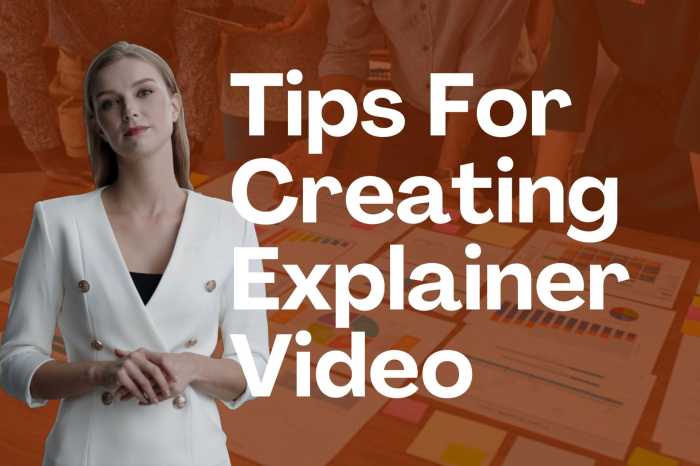Creating Explainer Videos kicks off the journey into the world of captivating content creation. From defining the essence of explainer videos to exploring their effectiveness, this guide is your ticket to mastering the art of visual storytelling.
As we delve deeper, you’ll uncover the secrets behind different types of explainer videos, the step-by-step process of crafting one, and the best practices to keep your audience hooked. So, buckle up and let’s dive into the realm of video creation!
Introduction to Explainer Videos: Creating Explainer Videos
Explainer videos are short animated videos that aim to explain a complex idea or product in a simple and engaging way. They are commonly used in marketing to grab the audience’s attention and communicate key messages effectively.
One of the main reasons why explainer videos are so effective in conveying complex information is their ability to combine visuals, audio, and storytelling. This multi-sensory approach helps viewers understand and retain information better compared to just reading text or listening to a presentation.
Examples of Successful Explainer Videos
- Dropbox: Dropbox created a simple yet effective explainer video that showcased their cloud storage service in a fun and engaging manner. The video helped increase their conversion rates significantly.
- Crazy Egg: Crazy Egg used an explainer video to demonstrate how their heat map tool works, making it easy for viewers to understand the benefits of their product visually.
- Squarespace: Squarespace’s explainer video highlighted the ease of creating a website using their platform, attracting a wider audience and boosting user sign-ups.
Types of Explainer Videos
Explainer videos come in various types, each with its unique style and purpose. Understanding the differences between them can help you choose the right one for your specific needs.
Animated Explainer Videos
Animated explainer videos use animation to convey complex ideas in a simple and engaging way. They are versatile and can be customized to match your brand’s tone and style. Animated videos are great for tech companies, startups, and educational institutions.
Live-Action Explainer Videos
Live-action explainer videos feature real people, settings, and props. They add a human touch to your message and can create a personal connection with your audience. These videos are ideal for businesses in the healthcare, real estate, and service industries.
Whiteboard Explainer Videos
Whiteboard explainer videos use hand-drawn illustrations on a white background to explain concepts step by step. They are great for simplifying complex processes or ideas. Whiteboard videos are popular among consulting firms, training organizations, and financial institutions.
Screen Recording Explainer Videos
Screen recording explainer videos capture on-screen activity, such as software demos or tutorials. They are perfect for showcasing digital products or explaining how to use specific features. Screen recording videos are commonly used by software companies, app developers, and online educators.
Stop Motion Explainer Videos, Creating Explainer Videos
Stop motion explainer videos involve manipulating physical objects frame by frame to create movement. They have a unique and creative look that can capture viewers’ attention. Stop motion videos work well for arts and crafts, toy companies, and creative agencies.
Steps to Create an Explainer Video

Creating an explainer video involves several important steps that contribute to the overall quality and effectiveness of the final product.
Scriptwriting
Scriptwriting is the foundation of any explainer video. It is essential to craft a clear and concise script that effectively communicates the message you want to convey to your audience.
- Define your target audience and the key message you want to deliver.
- Keep the script simple, engaging, and easy to understand.
- Include a strong call-to-action at the end to encourage viewers to take the desired action.
Storyboarding
Storyboarding is a crucial step in the video production process as it helps visualize the script and plan the visual elements of the video.
- Sketch out each scene and determine the visual elements needed for each shot.
- Establish the pacing, transitions, and flow of the video through the storyboard.
- Storyboarding enhances the video quality by ensuring a cohesive and engaging visual narrative.
Animation and Editing
Once the script and storyboard are finalized, it’s time to bring the video to life through animation and editing.
- Use animation software like Adobe After Effects or Toonly to create visually appealing animations.
- Edit the video to ensure smooth transitions, proper pacing, and seamless integration of visuals and narration.
- Add background music, sound effects, and voiceover to enhance the overall viewing experience.
Best Practices for Creating Engaging Explainer Videos

When it comes to creating engaging explainer videos, there are some best practices you should keep in mind to ensure your audience stays hooked and gets the message you’re trying to convey. Let’s dive into some key tips to make your explainer videos stand out from the crowd.
Keeping Explainer Videos Concise and to the Point
- Keep your script concise and focused on the main message you want to deliver.
- Avoid unnecessary details or information that may distract viewers from the main point.
- Use visuals to complement your message and help simplify complex ideas.
- Make sure your video is no longer than 2-3 minutes to maintain viewer engagement.
Significance of a Compelling Call-to-Action
- Include a clear and compelling call-to-action at the end of your video to guide viewers on the next steps.
- Encourage viewers to take action, whether it’s visiting your website, signing up for a newsletter, or making a purchase.
- Make the call-to-action stand out visually and ensure it aligns with the overall message of the video.
- Keep it simple and easy to understand to increase the chances of conversion.
Optimizing Explainer Videos for Different Social Media Platforms
- Consider the platform’s video specifications, such as aspect ratio and length, when creating your explainer video.
- Customize your video content to fit the platform’s audience and engagement preferences.
- Use subtitles or captions to make your video accessible to viewers who watch videos without sound.
- Promote your video organically and through paid ads to reach a wider audience on social media.







